Social Networking Essay
VerifiedAdded on 2020/02/05
|13
|3169
|64
Essay
AI Summary
This essay explores the multifaceted nature of social networking, examining its pervasive influence on modern society. It begins by defining social networking and its various platforms, highlighting its role in connecting individuals across geographical boundaries and facilitating the sharing of information and ideas in real-time. The essay then delves into the usage statistics of social media, particularly focusing on Facebook, illustrating its widespread adoption across diverse demographics. A significant portion of the essay is dedicated to analyzing how companies leverage social media for marketing, customer engagement, and market research, emphasizing both the opportunities and challenges involved. The advantages of social networking are discussed, including enhanced connectivity, the ability to connect with like-minded individuals, real-time information sharing, targeted advertising, and the accelerated news cycle. Conversely, the essay also addresses the disadvantages, such as the potential for backlash, cyberbullying, risks of fraud and identity theft, time wastage, and corporate invasion of privacy. The essay concludes by summarizing the key findings and reiterating the dual nature of social networking, presenting both its immense potential and inherent risks.

SOCIAL NETWORK
Reason to choose this topic:-
I have chosen this topic
to tell or explain the importance of social networking in our daily life.
This dissertation is belongs to our course because it is related to the
social issue which is very common and important to us. Social
networking is very important to keep in touch with one another.
Defination:-
Social networking is the practice of expanding the number
of one's business or social contacts by making connections through
individuals, often through social media sites such
as Facebook, Twitter, LinkedIn and Google.
EXPLANATION:-
A social networking service (also social
networking site, SNS or social media) is an online platform that
is used by people to build social networks or social relations
with other people who share similar personal or career interests,
activities, backgrounds or real-life connections. Social
networking is the use of internet-based social media programs
to make connections with friends, family, classmates, customers
and clients. Without social media or network we will not be able to
Reason to choose this topic:-
I have chosen this topic
to tell or explain the importance of social networking in our daily life.
This dissertation is belongs to our course because it is related to the
social issue which is very common and important to us. Social
networking is very important to keep in touch with one another.
Defination:-
Social networking is the practice of expanding the number
of one's business or social contacts by making connections through
individuals, often through social media sites such
as Facebook, Twitter, LinkedIn and Google.
EXPLANATION:-
A social networking service (also social
networking site, SNS or social media) is an online platform that
is used by people to build social networks or social relations
with other people who share similar personal or career interests,
activities, backgrounds or real-life connections. Social
networking is the use of internet-based social media programs
to make connections with friends, family, classmates, customers
and clients. Without social media or network we will not be able to
Paraphrase This Document
Need a fresh take? Get an instant paraphrase of this document with our AI Paraphraser
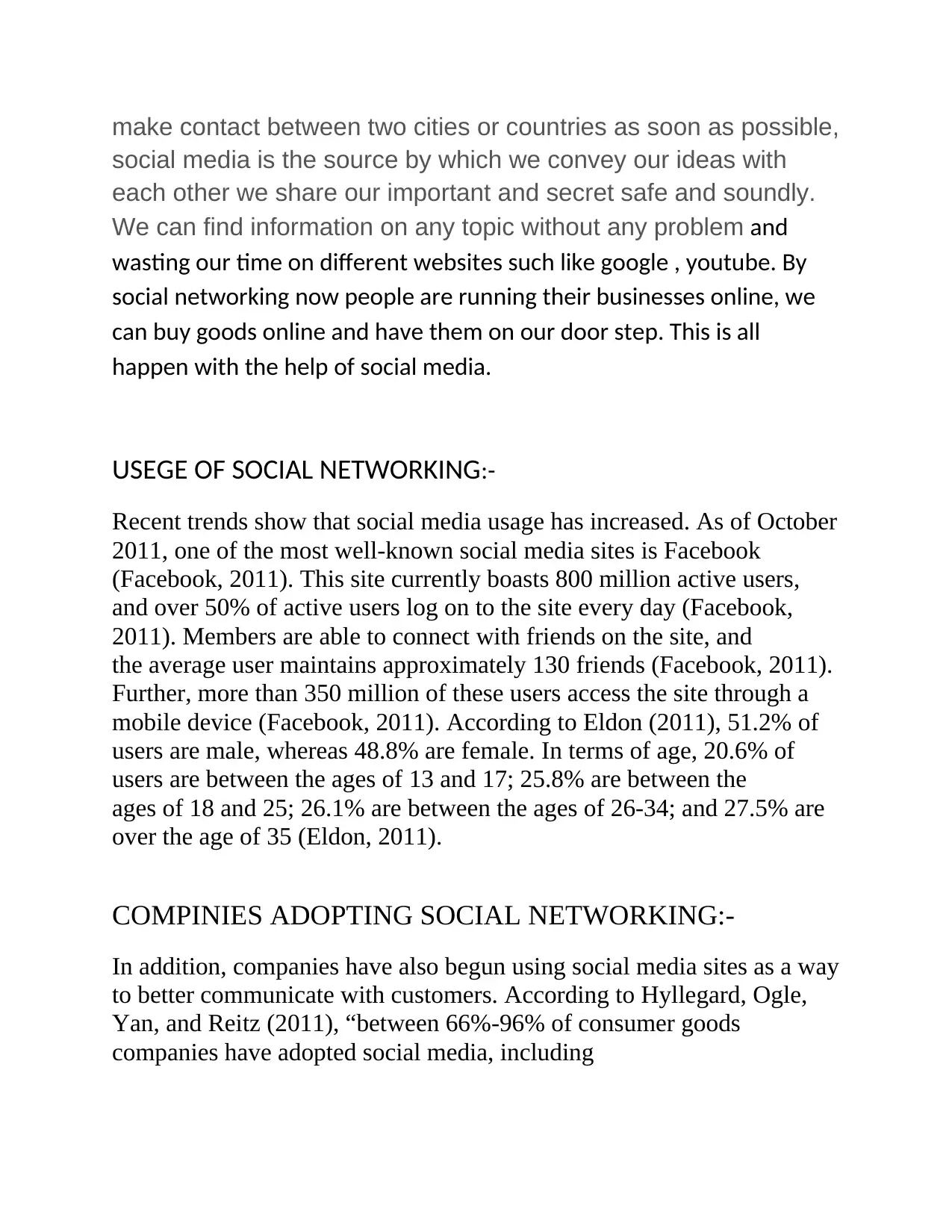
make contact between two cities or countries as soon as possible,
social media is the source by which we convey our ideas with
each other we share our important and secret safe and soundly.
We can find information on any topic without any problem and
wasting our time on different websites such like google , youtube. By
social networking now people are running their businesses online, we
can buy goods online and have them on our door step. This is all
happen with the help of social media.
USEGE OF SOCIAL NETWORKING:-
Recent trends show that social media usage has increased. As of October
2011, one of the most well-known social media sites is Facebook
(Facebook, 2011). This site currently boasts 800 million active users,
and over 50% of active users log on to the site every day (Facebook,
2011). Members are able to connect with friends on the site, and
the average user maintains approximately 130 friends (Facebook, 2011).
Further, more than 350 million of these users access the site through a
mobile device (Facebook, 2011). According to Eldon (2011), 51.2% of
users are male, whereas 48.8% are female. In terms of age, 20.6% of
users are between the ages of 13 and 17; 25.8% are between the
ages of 18 and 25; 26.1% are between the ages of 26-34; and 27.5% are
over the age of 35 (Eldon, 2011).
COMPINIES ADOPTING SOCIAL NETWORKING:-
In addition, companies have also begun using social media sites as a way
to better communicate with customers. According to Hyllegard, Ogle,
Yan, and Reitz (2011), “between 66%-96% of consumer goods
companies have adopted social media, including
social media is the source by which we convey our ideas with
each other we share our important and secret safe and soundly.
We can find information on any topic without any problem and
wasting our time on different websites such like google , youtube. By
social networking now people are running their businesses online, we
can buy goods online and have them on our door step. This is all
happen with the help of social media.
USEGE OF SOCIAL NETWORKING:-
Recent trends show that social media usage has increased. As of October
2011, one of the most well-known social media sites is Facebook
(Facebook, 2011). This site currently boasts 800 million active users,
and over 50% of active users log on to the site every day (Facebook,
2011). Members are able to connect with friends on the site, and
the average user maintains approximately 130 friends (Facebook, 2011).
Further, more than 350 million of these users access the site through a
mobile device (Facebook, 2011). According to Eldon (2011), 51.2% of
users are male, whereas 48.8% are female. In terms of age, 20.6% of
users are between the ages of 13 and 17; 25.8% are between the
ages of 18 and 25; 26.1% are between the ages of 26-34; and 27.5% are
over the age of 35 (Eldon, 2011).
COMPINIES ADOPTING SOCIAL NETWORKING:-
In addition, companies have also begun using social media sites as a way
to better communicate with customers. According to Hyllegard, Ogle,
Yan, and Reitz (2011), “between 66%-96% of consumer goods
companies have adopted social media, including
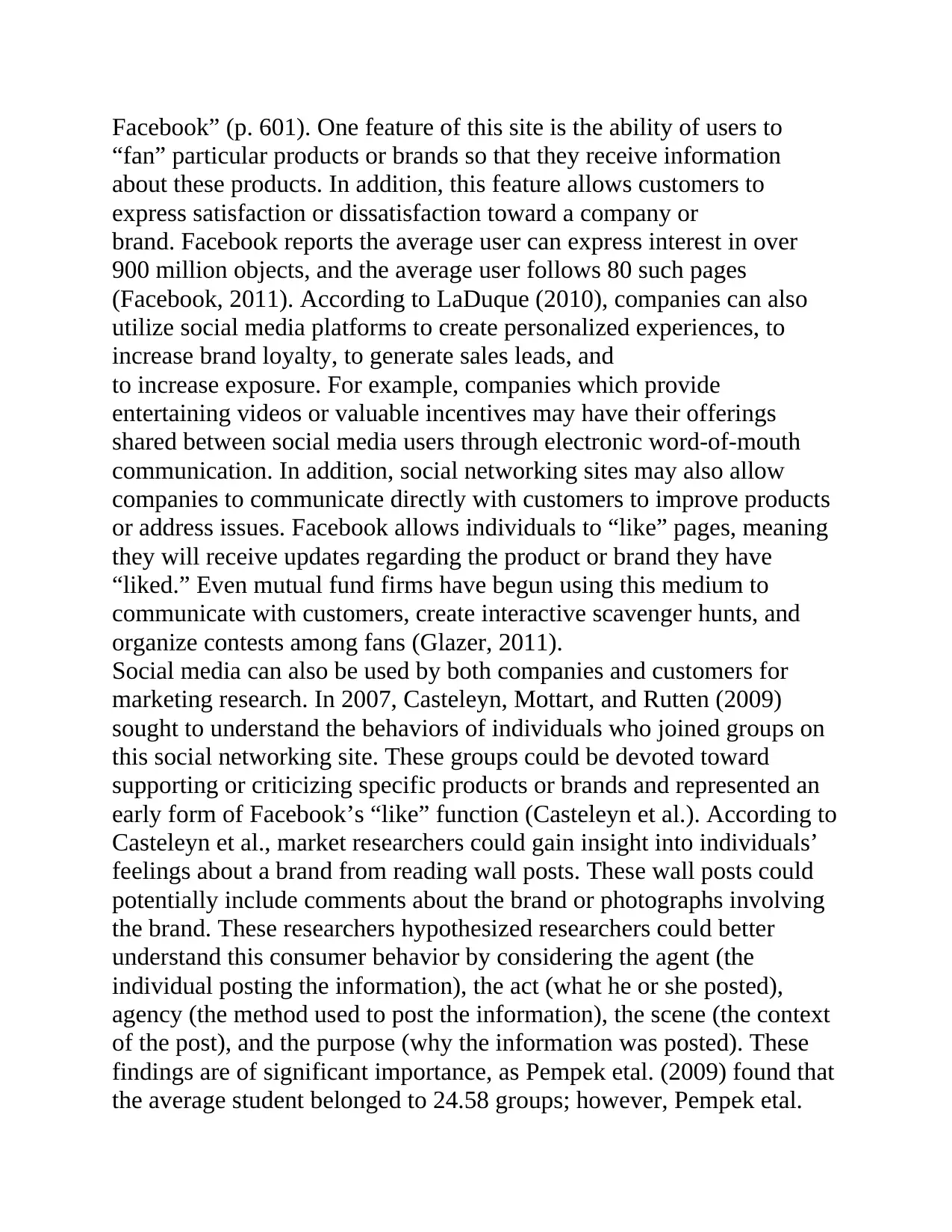
Facebook” (p. 601). One feature of this site is the ability of users to
“fan” particular products or brands so that they receive information
about these products. In addition, this feature allows customers to
express satisfaction or dissatisfaction toward a company or
brand. Facebook reports the average user can express interest in over
900 million objects, and the average user follows 80 such pages
(Facebook, 2011). According to LaDuque (2010), companies can also
utilize social media platforms to create personalized experiences, to
increase brand loyalty, to generate sales leads, and
to increase exposure. For example, companies which provide
entertaining videos or valuable incentives may have their offerings
shared between social media users through electronic word-of-mouth
communication. In addition, social networking sites may also allow
companies to communicate directly with customers to improve products
or address issues. Facebook allows individuals to “like” pages, meaning
they will receive updates regarding the product or brand they have
“liked.” Even mutual fund firms have begun using this medium to
communicate with customers, create interactive scavenger hunts, and
organize contests among fans (Glazer, 2011).
Social media can also be used by both companies and customers for
marketing research. In 2007, Casteleyn, Mottart, and Rutten (2009)
sought to understand the behaviors of individuals who joined groups on
this social networking site. These groups could be devoted toward
supporting or criticizing specific products or brands and represented an
early form of Facebook’s “like” function (Casteleyn et al.). According to
Casteleyn et al., market researchers could gain insight into individuals’
feelings about a brand from reading wall posts. These wall posts could
potentially include comments about the brand or photographs involving
the brand. These researchers hypothesized researchers could better
understand this consumer behavior by considering the agent (the
individual posting the information), the act (what he or she posted),
agency (the method used to post the information), the scene (the context
of the post), and the purpose (why the information was posted). These
findings are of significant importance, as Pempek etal. (2009) found that
the average student belonged to 24.58 groups; however, Pempek etal.
“fan” particular products or brands so that they receive information
about these products. In addition, this feature allows customers to
express satisfaction or dissatisfaction toward a company or
brand. Facebook reports the average user can express interest in over
900 million objects, and the average user follows 80 such pages
(Facebook, 2011). According to LaDuque (2010), companies can also
utilize social media platforms to create personalized experiences, to
increase brand loyalty, to generate sales leads, and
to increase exposure. For example, companies which provide
entertaining videos or valuable incentives may have their offerings
shared between social media users through electronic word-of-mouth
communication. In addition, social networking sites may also allow
companies to communicate directly with customers to improve products
or address issues. Facebook allows individuals to “like” pages, meaning
they will receive updates regarding the product or brand they have
“liked.” Even mutual fund firms have begun using this medium to
communicate with customers, create interactive scavenger hunts, and
organize contests among fans (Glazer, 2011).
Social media can also be used by both companies and customers for
marketing research. In 2007, Casteleyn, Mottart, and Rutten (2009)
sought to understand the behaviors of individuals who joined groups on
this social networking site. These groups could be devoted toward
supporting or criticizing specific products or brands and represented an
early form of Facebook’s “like” function (Casteleyn et al.). According to
Casteleyn et al., market researchers could gain insight into individuals’
feelings about a brand from reading wall posts. These wall posts could
potentially include comments about the brand or photographs involving
the brand. These researchers hypothesized researchers could better
understand this consumer behavior by considering the agent (the
individual posting the information), the act (what he or she posted),
agency (the method used to post the information), the scene (the context
of the post), and the purpose (why the information was posted). These
findings are of significant importance, as Pempek etal. (2009) found that
the average student belonged to 24.58 groups; however, Pempek etal.
⊘ This is a preview!⊘
Do you want full access?
Subscribe today to unlock all pages.

Trusted by 1+ million students worldwide
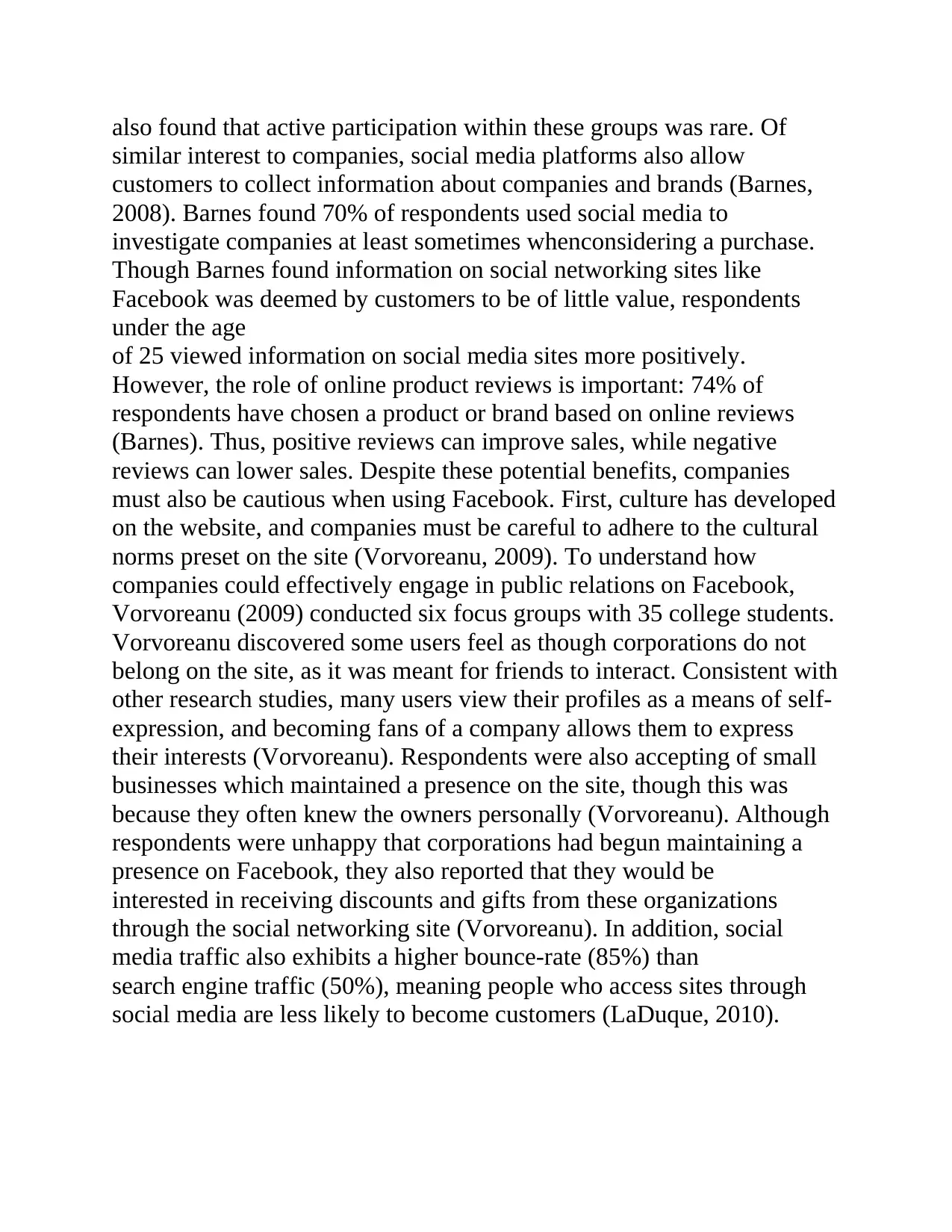
also found that active participation within these groups was rare. Of
similar interest to companies, social media platforms also allow
customers to collect information about companies and brands (Barnes,
2008). Barnes found 70% of respondents used social media to
investigate companies at least sometimes whenconsidering a purchase.
Though Barnes found information on social networking sites like
Facebook was deemed by customers to be of little value, respondents
under the age
of 25 viewed information on social media sites more positively.
However, the role of online product reviews is important: 74% of
respondents have chosen a product or brand based on online reviews
(Barnes). Thus, positive reviews can improve sales, while negative
reviews can lower sales. Despite these potential benefits, companies
must also be cautious when using Facebook. First, culture has developed
on the website, and companies must be careful to adhere to the cultural
norms preset on the site (Vorvoreanu, 2009). To understand how
companies could effectively engage in public relations on Facebook,
Vorvoreanu (2009) conducted six focus groups with 35 college students.
Vorvoreanu discovered some users feel as though corporations do not
belong on the site, as it was meant for friends to interact. Consistent with
other research studies, many users view their profiles as a means of self-
expression, and becoming fans of a company allows them to express
their interests (Vorvoreanu). Respondents were also accepting of small
businesses which maintained a presence on the site, though this was
because they often knew the owners personally (Vorvoreanu). Although
respondents were unhappy that corporations had begun maintaining a
presence on Facebook, they also reported that they would be
interested in receiving discounts and gifts from these organizations
through the social networking site (Vorvoreanu). In addition, social
media traffic also exhibits a higher bounce-rate (85%) than
search engine traffic (50%), meaning people who access sites through
social media are less likely to become customers (LaDuque, 2010).
similar interest to companies, social media platforms also allow
customers to collect information about companies and brands (Barnes,
2008). Barnes found 70% of respondents used social media to
investigate companies at least sometimes whenconsidering a purchase.
Though Barnes found information on social networking sites like
Facebook was deemed by customers to be of little value, respondents
under the age
of 25 viewed information on social media sites more positively.
However, the role of online product reviews is important: 74% of
respondents have chosen a product or brand based on online reviews
(Barnes). Thus, positive reviews can improve sales, while negative
reviews can lower sales. Despite these potential benefits, companies
must also be cautious when using Facebook. First, culture has developed
on the website, and companies must be careful to adhere to the cultural
norms preset on the site (Vorvoreanu, 2009). To understand how
companies could effectively engage in public relations on Facebook,
Vorvoreanu (2009) conducted six focus groups with 35 college students.
Vorvoreanu discovered some users feel as though corporations do not
belong on the site, as it was meant for friends to interact. Consistent with
other research studies, many users view their profiles as a means of self-
expression, and becoming fans of a company allows them to express
their interests (Vorvoreanu). Respondents were also accepting of small
businesses which maintained a presence on the site, though this was
because they often knew the owners personally (Vorvoreanu). Although
respondents were unhappy that corporations had begun maintaining a
presence on Facebook, they also reported that they would be
interested in receiving discounts and gifts from these organizations
through the social networking site (Vorvoreanu). In addition, social
media traffic also exhibits a higher bounce-rate (85%) than
search engine traffic (50%), meaning people who access sites through
social media are less likely to become customers (LaDuque, 2010).
Paraphrase This Document
Need a fresh take? Get an instant paraphrase of this document with our AI Paraphraser
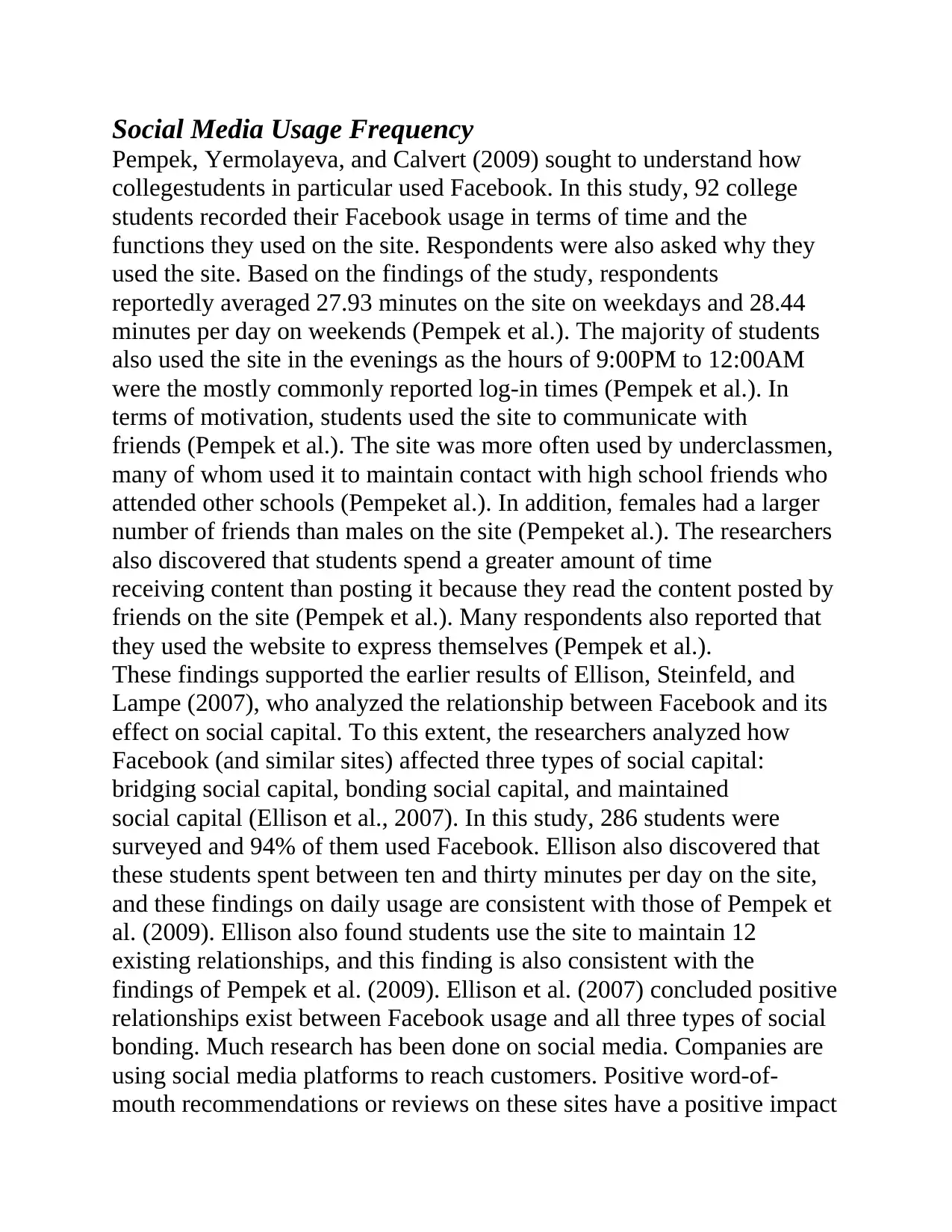
Social Media Usage Frequency
Pempek, Yermolayeva, and Calvert (2009) sought to understand how
collegestudents in particular used Facebook. In this study, 92 college
students recorded their Facebook usage in terms of time and the
functions they used on the site. Respondents were also asked why they
used the site. Based on the findings of the study, respondents
reportedly averaged 27.93 minutes on the site on weekdays and 28.44
minutes per day on weekends (Pempek et al.). The majority of students
also used the site in the evenings as the hours of 9:00PM to 12:00AM
were the mostly commonly reported log-in times (Pempek et al.). In
terms of motivation, students used the site to communicate with
friends (Pempek et al.). The site was more often used by underclassmen,
many of whom used it to maintain contact with high school friends who
attended other schools (Pempeket al.). In addition, females had a larger
number of friends than males on the site (Pempeket al.). The researchers
also discovered that students spend a greater amount of time
receiving content than posting it because they read the content posted by
friends on the site (Pempek et al.). Many respondents also reported that
they used the website to express themselves (Pempek et al.).
These findings supported the earlier results of Ellison, Steinfeld, and
Lampe (2007), who analyzed the relationship between Facebook and its
effect on social capital. To this extent, the researchers analyzed how
Facebook (and similar sites) affected three types of social capital:
bridging social capital, bonding social capital, and maintained
social capital (Ellison et al., 2007). In this study, 286 students were
surveyed and 94% of them used Facebook. Ellison also discovered that
these students spent between ten and thirty minutes per day on the site,
and these findings on daily usage are consistent with those of Pempek et
al. (2009). Ellison also found students use the site to maintain 12
existing relationships, and this finding is also consistent with the
findings of Pempek et al. (2009). Ellison et al. (2007) concluded positive
relationships exist between Facebook usage and all three types of social
bonding. Much research has been done on social media. Companies are
using social media platforms to reach customers. Positive word-of-
mouth recommendations or reviews on these sites have a positive impact
Pempek, Yermolayeva, and Calvert (2009) sought to understand how
collegestudents in particular used Facebook. In this study, 92 college
students recorded their Facebook usage in terms of time and the
functions they used on the site. Respondents were also asked why they
used the site. Based on the findings of the study, respondents
reportedly averaged 27.93 minutes on the site on weekdays and 28.44
minutes per day on weekends (Pempek et al.). The majority of students
also used the site in the evenings as the hours of 9:00PM to 12:00AM
were the mostly commonly reported log-in times (Pempek et al.). In
terms of motivation, students used the site to communicate with
friends (Pempek et al.). The site was more often used by underclassmen,
many of whom used it to maintain contact with high school friends who
attended other schools (Pempeket al.). In addition, females had a larger
number of friends than males on the site (Pempeket al.). The researchers
also discovered that students spend a greater amount of time
receiving content than posting it because they read the content posted by
friends on the site (Pempek et al.). Many respondents also reported that
they used the website to express themselves (Pempek et al.).
These findings supported the earlier results of Ellison, Steinfeld, and
Lampe (2007), who analyzed the relationship between Facebook and its
effect on social capital. To this extent, the researchers analyzed how
Facebook (and similar sites) affected three types of social capital:
bridging social capital, bonding social capital, and maintained
social capital (Ellison et al., 2007). In this study, 286 students were
surveyed and 94% of them used Facebook. Ellison also discovered that
these students spent between ten and thirty minutes per day on the site,
and these findings on daily usage are consistent with those of Pempek et
al. (2009). Ellison also found students use the site to maintain 12
existing relationships, and this finding is also consistent with the
findings of Pempek et al. (2009). Ellison et al. (2007) concluded positive
relationships exist between Facebook usage and all three types of social
bonding. Much research has been done on social media. Companies are
using social media platforms to reach customers. Positive word-of-
mouth recommendations or reviews on these sites have a positive impact
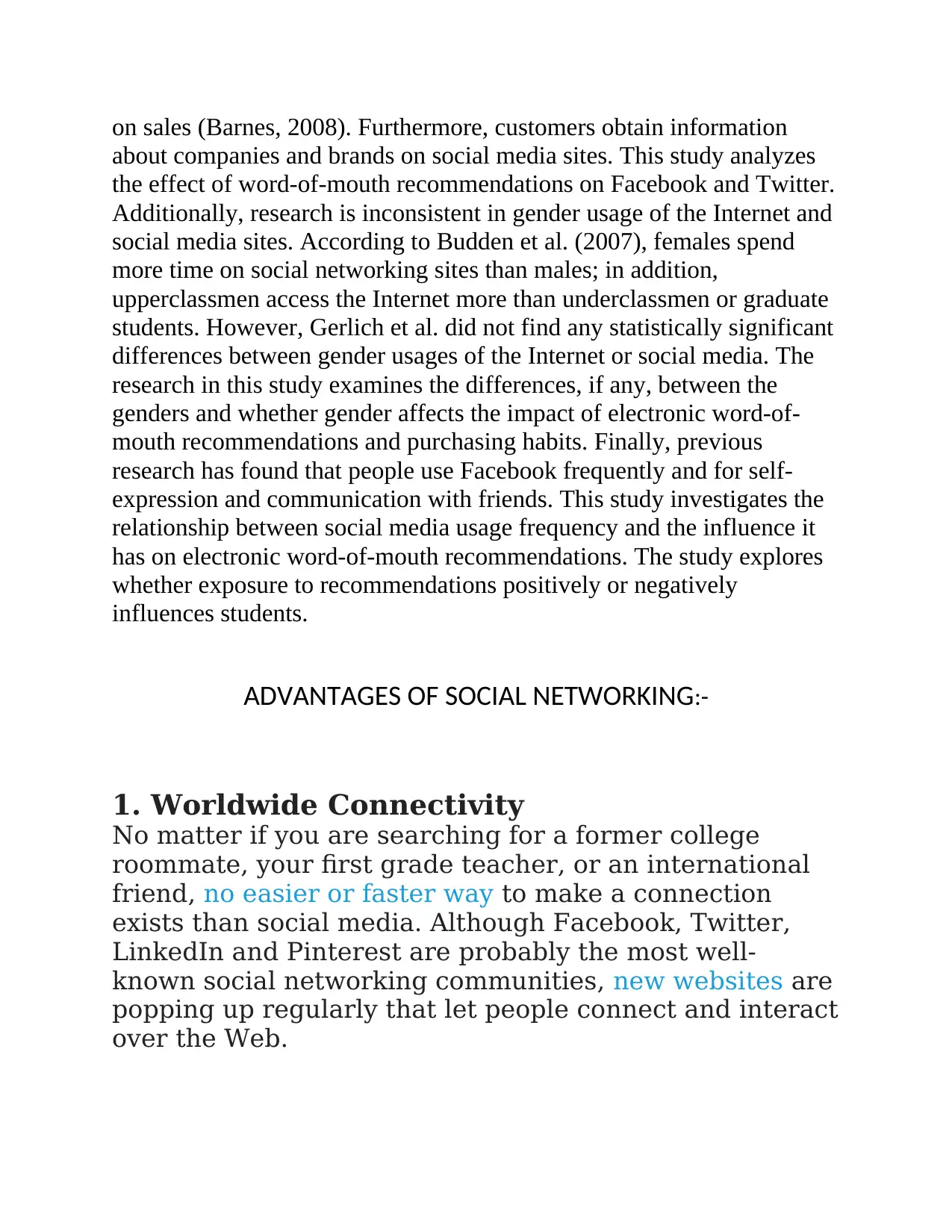
on sales (Barnes, 2008). Furthermore, customers obtain information
about companies and brands on social media sites. This study analyzes
the effect of word-of-mouth recommendations on Facebook and Twitter.
Additionally, research is inconsistent in gender usage of the Internet and
social media sites. According to Budden et al. (2007), females spend
more time on social networking sites than males; in addition,
upperclassmen access the Internet more than underclassmen or graduate
students. However, Gerlich et al. did not find any statistically significant
differences between gender usages of the Internet or social media. The
research in this study examines the differences, if any, between the
genders and whether gender affects the impact of electronic word-of-
mouth recommendations and purchasing habits. Finally, previous
research has found that people use Facebook frequently and for self-
expression and communication with friends. This study investigates the
relationship between social media usage frequency and the influence it
has on electronic word-of-mouth recommendations. The study explores
whether exposure to recommendations positively or negatively
influences students.
ADVANTAGES OF SOCIAL NETWORKING:-
1. Worldwide Connectivity
No matter if you are searching for a former college
roommate, your first grade teacher, or an international
friend, no easier or faster way to make a connection
exists than social media. Although Facebook, Twitter,
LinkedIn and Pinterest are probably the most well-
known social networking communities, new websites are
popping up regularly that let people connect and interact
over the Web.
about companies and brands on social media sites. This study analyzes
the effect of word-of-mouth recommendations on Facebook and Twitter.
Additionally, research is inconsistent in gender usage of the Internet and
social media sites. According to Budden et al. (2007), females spend
more time on social networking sites than males; in addition,
upperclassmen access the Internet more than underclassmen or graduate
students. However, Gerlich et al. did not find any statistically significant
differences between gender usages of the Internet or social media. The
research in this study examines the differences, if any, between the
genders and whether gender affects the impact of electronic word-of-
mouth recommendations and purchasing habits. Finally, previous
research has found that people use Facebook frequently and for self-
expression and communication with friends. This study investigates the
relationship between social media usage frequency and the influence it
has on electronic word-of-mouth recommendations. The study explores
whether exposure to recommendations positively or negatively
influences students.
ADVANTAGES OF SOCIAL NETWORKING:-
1. Worldwide Connectivity
No matter if you are searching for a former college
roommate, your first grade teacher, or an international
friend, no easier or faster way to make a connection
exists than social media. Although Facebook, Twitter,
LinkedIn and Pinterest are probably the most well-
known social networking communities, new websites are
popping up regularly that let people connect and interact
over the Web.
⊘ This is a preview!⊘
Do you want full access?
Subscribe today to unlock all pages.

Trusted by 1+ million students worldwide
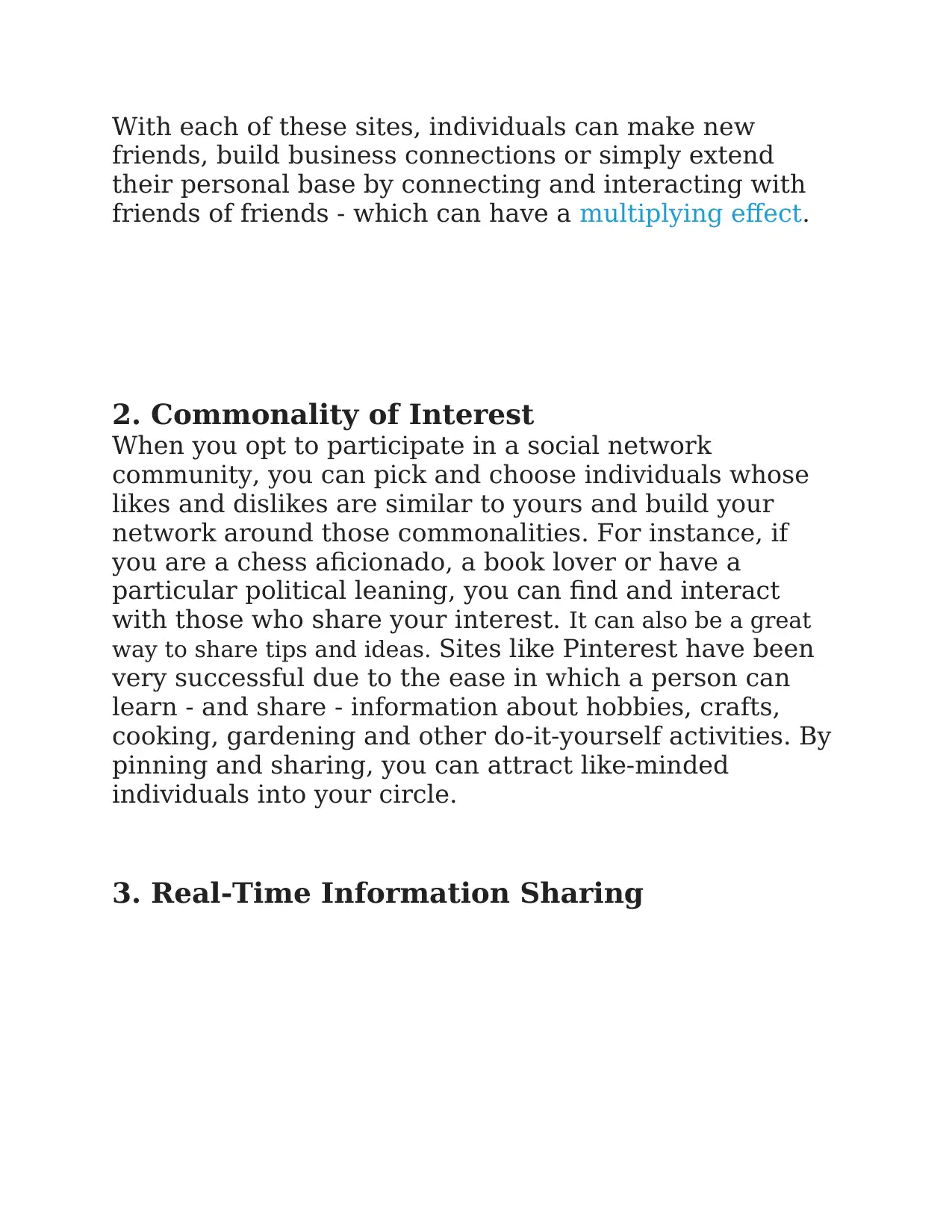
With each of these sites, individuals can make new
friends, build business connections or simply extend
their personal base by connecting and interacting with
friends of friends - which can have a multiplying effect.
2. Commonality of Interest
When you opt to participate in a social network
community, you can pick and choose individuals whose
likes and dislikes are similar to yours and build your
network around those commonalities. For instance, if
you are a chess aficionado, a book lover or have a
particular political leaning, you can find and interact
with those who share your interest. It can also be a great
way to share tips and ideas. Sites like Pinterest have been
very successful due to the ease in which a person can
learn - and share - information about hobbies, crafts,
cooking, gardening and other do-it-yourself activities. By
pinning and sharing, you can attract like-minded
individuals into your circle.
3. Real-Time Information Sharing
friends, build business connections or simply extend
their personal base by connecting and interacting with
friends of friends - which can have a multiplying effect.
2. Commonality of Interest
When you opt to participate in a social network
community, you can pick and choose individuals whose
likes and dislikes are similar to yours and build your
network around those commonalities. For instance, if
you are a chess aficionado, a book lover or have a
particular political leaning, you can find and interact
with those who share your interest. It can also be a great
way to share tips and ideas. Sites like Pinterest have been
very successful due to the ease in which a person can
learn - and share - information about hobbies, crafts,
cooking, gardening and other do-it-yourself activities. By
pinning and sharing, you can attract like-minded
individuals into your circle.
3. Real-Time Information Sharing
Paraphrase This Document
Need a fresh take? Get an instant paraphrase of this document with our AI Paraphraser
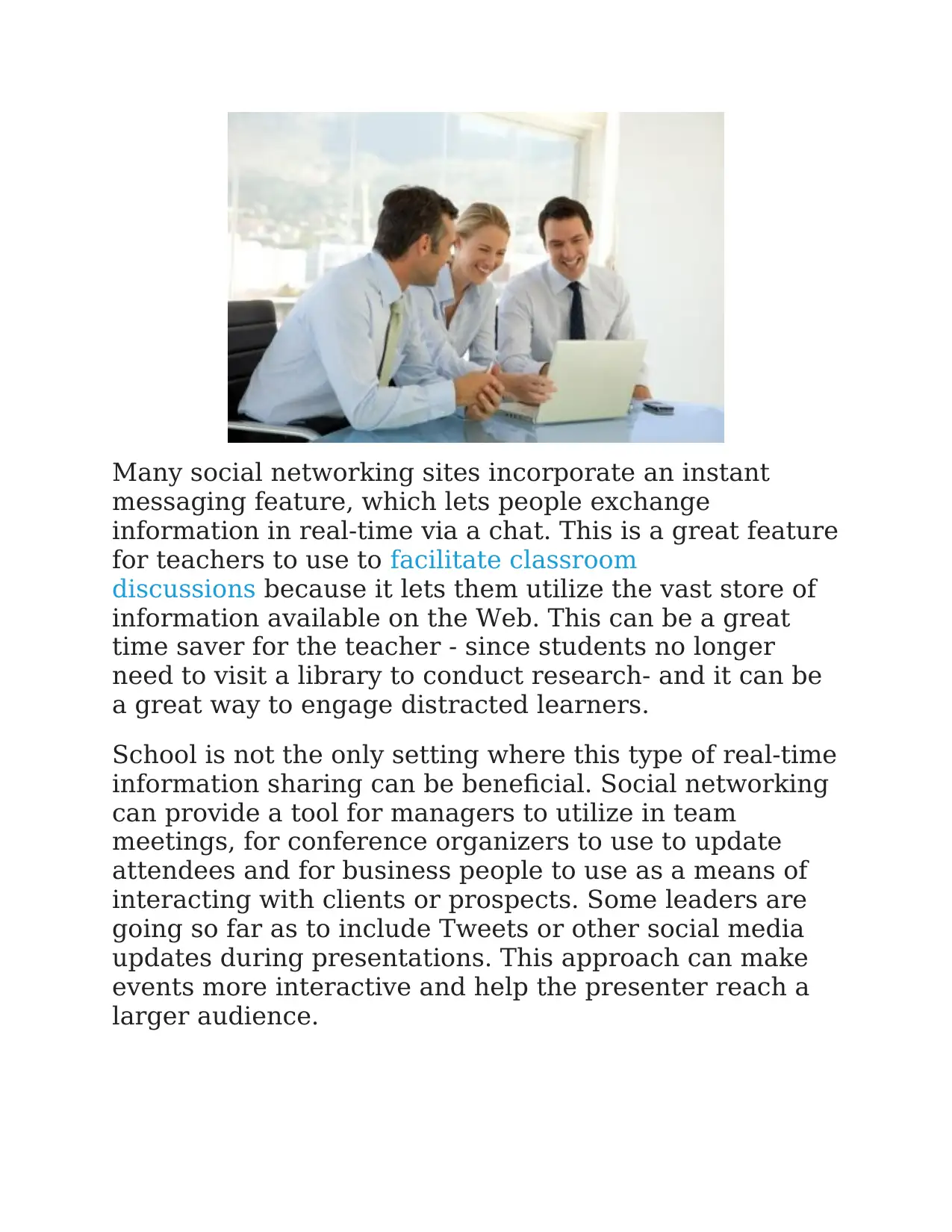
Many social networking sites incorporate an instant
messaging feature, which lets people exchange
information in real-time via a chat. This is a great feature
for teachers to use to facilitate classroom
discussions because it lets them utilize the vast store of
information available on the Web. This can be a great
time saver for the teacher - since students no longer
need to visit a library to conduct research- and it can be
a great way to engage distracted learners.
School is not the only setting where this type of real-time
information sharing can be beneficial. Social networking
can provide a tool for managers to utilize in team
meetings, for conference organizers to use to update
attendees and for business people to use as a means of
interacting with clients or prospects. Some leaders are
going so far as to include Tweets or other social media
updates during presentations. This approach can make
events more interactive and help the presenter reach a
larger audience.
messaging feature, which lets people exchange
information in real-time via a chat. This is a great feature
for teachers to use to facilitate classroom
discussions because it lets them utilize the vast store of
information available on the Web. This can be a great
time saver for the teacher - since students no longer
need to visit a library to conduct research- and it can be
a great way to engage distracted learners.
School is not the only setting where this type of real-time
information sharing can be beneficial. Social networking
can provide a tool for managers to utilize in team
meetings, for conference organizers to use to update
attendees and for business people to use as a means of
interacting with clients or prospects. Some leaders are
going so far as to include Tweets or other social media
updates during presentations. This approach can make
events more interactive and help the presenter reach a
larger audience.

4. Targeted Advertising
Whether you are non-profit organization that needs to
get the word out about an upcoming fundraiser or a
business owner marketing a new product or service,
there's no better way than social media to get
your message in front of millions of people 24/7.
5. Increased News Cycle Speed
Undoubtedly, social networking has revolutionized the
speed of the news cycle. Most news organizations now
rely on social media sites to collect and share
information. Social media - especially Twitter - is steadily
becoming a mainstream source for breaking news. Today
an individual can know, in real time, what is happening
throughout the world. This has led to the development of
a nearly instantaneous news cycle as everything from
terrorist attacks to local car crashes get shared on social
media, quickly alerting their intended audience of the
event.
DISADVANTAGES OF SOCIAL NETWORKING
1. Backlash
Whether you are non-profit organization that needs to
get the word out about an upcoming fundraiser or a
business owner marketing a new product or service,
there's no better way than social media to get
your message in front of millions of people 24/7.
5. Increased News Cycle Speed
Undoubtedly, social networking has revolutionized the
speed of the news cycle. Most news organizations now
rely on social media sites to collect and share
information. Social media - especially Twitter - is steadily
becoming a mainstream source for breaking news. Today
an individual can know, in real time, what is happening
throughout the world. This has led to the development of
a nearly instantaneous news cycle as everything from
terrorist attacks to local car crashes get shared on social
media, quickly alerting their intended audience of the
event.
DISADVANTAGES OF SOCIAL NETWORKING
1. Backlash
⊘ This is a preview!⊘
Do you want full access?
Subscribe today to unlock all pages.

Trusted by 1+ million students worldwide

A joke among friends is one thing but a joke with the
world at-large is much different. When potentially
offensive content is posted online, the amount of
feedback can be excessive and is often brutal. This is
particularly true with highly opinionated subjects like
politics and religion. This backlash can also have a long-
term impact on a person's future, especially in a world
that has fallen prey to over-sharing. Even high school
students are learning that comments they post on social
media can influence whether a college approves their
application for admission.
2. Cyberbullying and Crimes Against Children
world at-large is much different. When potentially
offensive content is posted online, the amount of
feedback can be excessive and is often brutal. This is
particularly true with highly opinionated subjects like
politics and religion. This backlash can also have a long-
term impact on a person's future, especially in a world
that has fallen prey to over-sharing. Even high school
students are learning that comments they post on social
media can influence whether a college approves their
application for admission.
2. Cyberbullying and Crimes Against Children
Paraphrase This Document
Need a fresh take? Get an instant paraphrase of this document with our AI Paraphraser
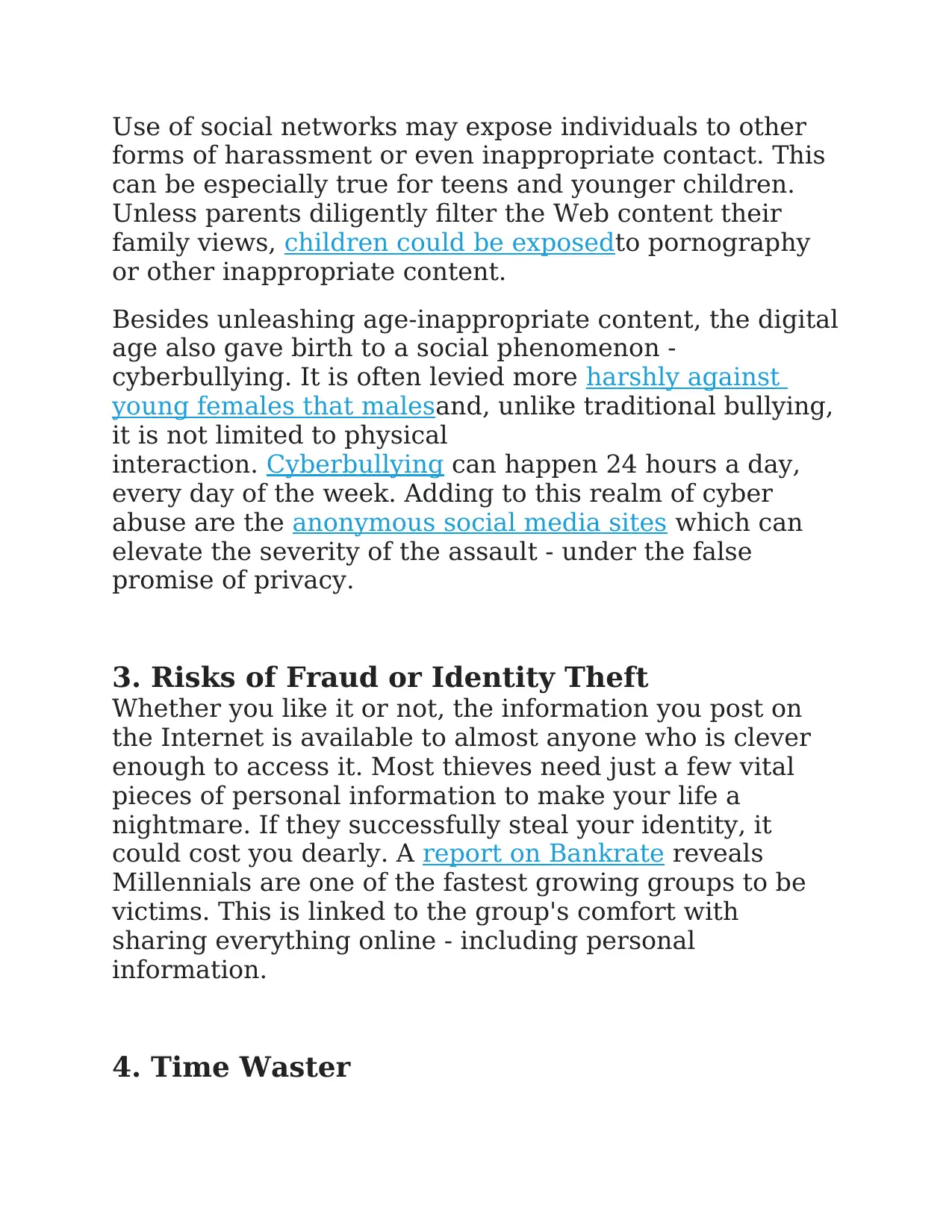
Use of social networks may expose individuals to other
forms of harassment or even inappropriate contact. This
can be especially true for teens and younger children.
Unless parents diligently filter the Web content their
family views, children could be exposedto pornography
or other inappropriate content.
Besides unleashing age-inappropriate content, the digital
age also gave birth to a social phenomenon -
cyberbullying. It is often levied more harshly against
young females that malesand, unlike traditional bullying,
it is not limited to physical
interaction. Cyberbullying can happen 24 hours a day,
every day of the week. Adding to this realm of cyber
abuse are the anonymous social media sites which can
elevate the severity of the assault - under the false
promise of privacy.
3. Risks of Fraud or Identity Theft
Whether you like it or not, the information you post on
the Internet is available to almost anyone who is clever
enough to access it. Most thieves need just a few vital
pieces of personal information to make your life a
nightmare. If they successfully steal your identity, it
could cost you dearly. A report on Bankrate reveals
Millennials are one of the fastest growing groups to be
victims. This is linked to the group's comfort with
sharing everything online - including personal
information.
4. Time Waster
forms of harassment or even inappropriate contact. This
can be especially true for teens and younger children.
Unless parents diligently filter the Web content their
family views, children could be exposedto pornography
or other inappropriate content.
Besides unleashing age-inappropriate content, the digital
age also gave birth to a social phenomenon -
cyberbullying. It is often levied more harshly against
young females that malesand, unlike traditional bullying,
it is not limited to physical
interaction. Cyberbullying can happen 24 hours a day,
every day of the week. Adding to this realm of cyber
abuse are the anonymous social media sites which can
elevate the severity of the assault - under the false
promise of privacy.
3. Risks of Fraud or Identity Theft
Whether you like it or not, the information you post on
the Internet is available to almost anyone who is clever
enough to access it. Most thieves need just a few vital
pieces of personal information to make your life a
nightmare. If they successfully steal your identity, it
could cost you dearly. A report on Bankrate reveals
Millennials are one of the fastest growing groups to be
victims. This is linked to the group's comfort with
sharing everything online - including personal
information.
4. Time Waster
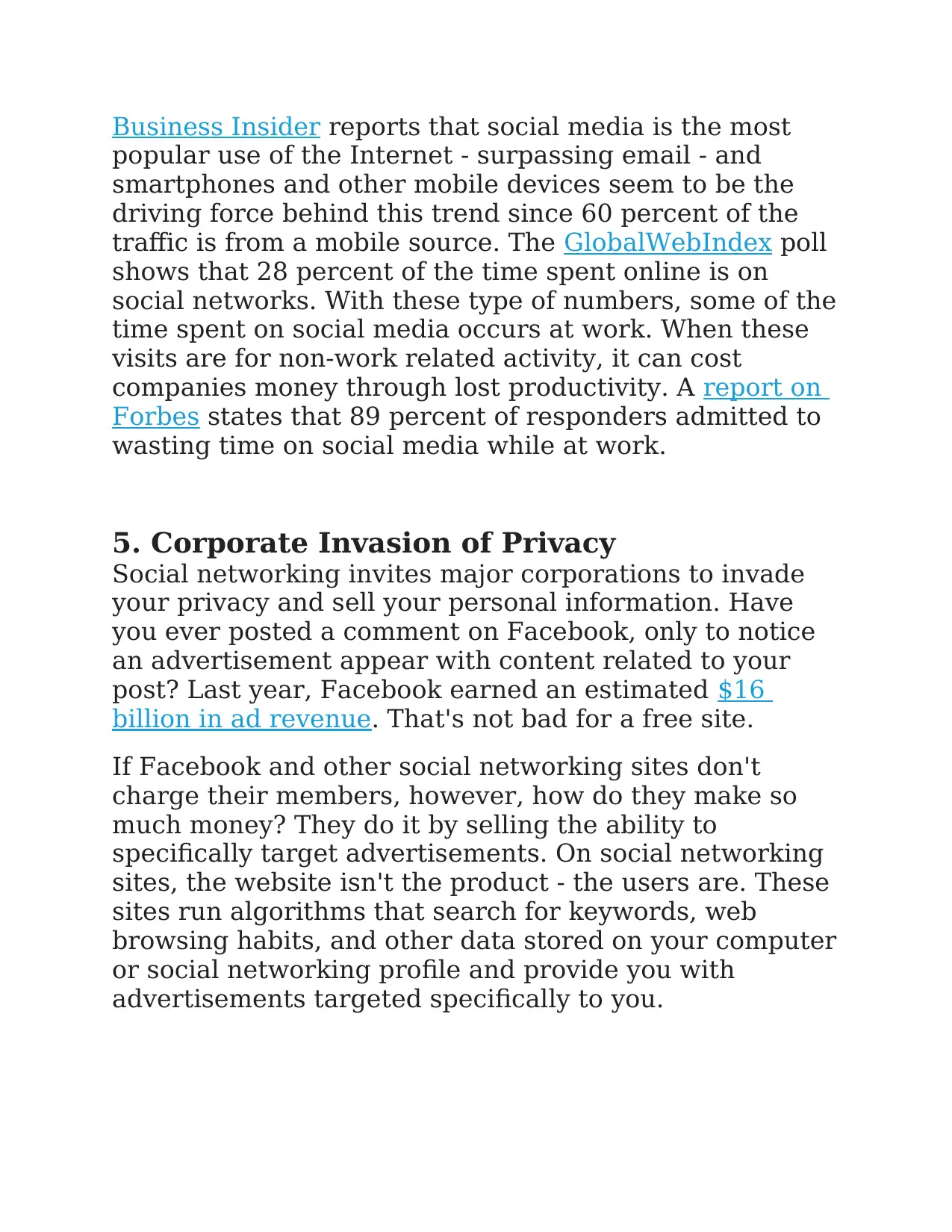
Business Insider reports that social media is the most
popular use of the Internet - surpassing email - and
smartphones and other mobile devices seem to be the
driving force behind this trend since 60 percent of the
traffic is from a mobile source. The GlobalWebIndex poll
shows that 28 percent of the time spent online is on
social networks. With these type of numbers, some of the
time spent on social media occurs at work. When these
visits are for non-work related activity, it can cost
companies money through lost productivity. A report on
Forbes states that 89 percent of responders admitted to
wasting time on social media while at work.
5. Corporate Invasion of Privacy
Social networking invites major corporations to invade
your privacy and sell your personal information. Have
you ever posted a comment on Facebook, only to notice
an advertisement appear with content related to your
post? Last year, Facebook earned an estimated $16
billion in ad revenue. That's not bad for a free site.
If Facebook and other social networking sites don't
charge their members, however, how do they make so
much money? They do it by selling the ability to
specifically target advertisements. On social networking
sites, the website isn't the product - the users are. These
sites run algorithms that search for keywords, web
browsing habits, and other data stored on your computer
or social networking profile and provide you with
advertisements targeted specifically to you.
popular use of the Internet - surpassing email - and
smartphones and other mobile devices seem to be the
driving force behind this trend since 60 percent of the
traffic is from a mobile source. The GlobalWebIndex poll
shows that 28 percent of the time spent online is on
social networks. With these type of numbers, some of the
time spent on social media occurs at work. When these
visits are for non-work related activity, it can cost
companies money through lost productivity. A report on
Forbes states that 89 percent of responders admitted to
wasting time on social media while at work.
5. Corporate Invasion of Privacy
Social networking invites major corporations to invade
your privacy and sell your personal information. Have
you ever posted a comment on Facebook, only to notice
an advertisement appear with content related to your
post? Last year, Facebook earned an estimated $16
billion in ad revenue. That's not bad for a free site.
If Facebook and other social networking sites don't
charge their members, however, how do they make so
much money? They do it by selling the ability to
specifically target advertisements. On social networking
sites, the website isn't the product - the users are. These
sites run algorithms that search for keywords, web
browsing habits, and other data stored on your computer
or social networking profile and provide you with
advertisements targeted specifically to you.
⊘ This is a preview!⊘
Do you want full access?
Subscribe today to unlock all pages.

Trusted by 1+ million students worldwide
1 out of 13
Related Documents
Your All-in-One AI-Powered Toolkit for Academic Success.
+13062052269
info@desklib.com
Available 24*7 on WhatsApp / Email
![[object Object]](/_next/static/media/star-bottom.7253800d.svg)
Unlock your academic potential
Copyright © 2020–2025 A2Z Services. All Rights Reserved. Developed and managed by ZUCOL.





